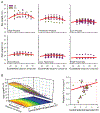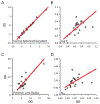Modelling eye lengths and refractions in the periphery
- PMID: 36999932
- PMCID: PMC11732252
- DOI: 10.1111/opo.13133
Modelling eye lengths and refractions in the periphery
Abstract
Purpose: To create a simplified model of the eye by which we can specify a key optical characteristic of the crystalline lens, namely its power.
Methods: Cycloplegic refraction and axial length were obtained in 60 eyes of 30 healthy subjects at eccentricities spanning 40° nasal to 40° temporal and were fitted with a three-dimensional parabolic model. Keratometric values and geometric distances to the cornea, lens and retina from 45 eyes supplied a numerical ray tracing model. Posterior lens curvature (PLC) was found by optimising the refractive data using a fixed lens equivalent refractive index ( ). Then, was found using a fixed PLC.
Results: Eccentric refractive errors were relatively hyperopic in eyes with central refractions ≤-1.44 D but relatively myopic in emmetropes and hyperopes. Posterior lens power, which cannot be measured directly, was derived from the optimised model lens. There was a weak, negative association between derived PLC and central spherical equivalent refraction. Regardless of refractive error, the posterior retinal curvature remained fixed.
Conclusions: By combining both on- and off-axis refractions and eye length measurements, this simplified model enabled the specification of posterior lens power and captured off-axis lenticular characteristics. The broad distribution in off-axis lens power represents a notable contrast to the relative stability of retinal curvature.
Keywords: hyperopia; myopia; optics.
© 2023 College of Optometrists.
Figures






References
Publication types
MeSH terms
Grants and funding
LinkOut - more resources
Full Text Sources
Medical

